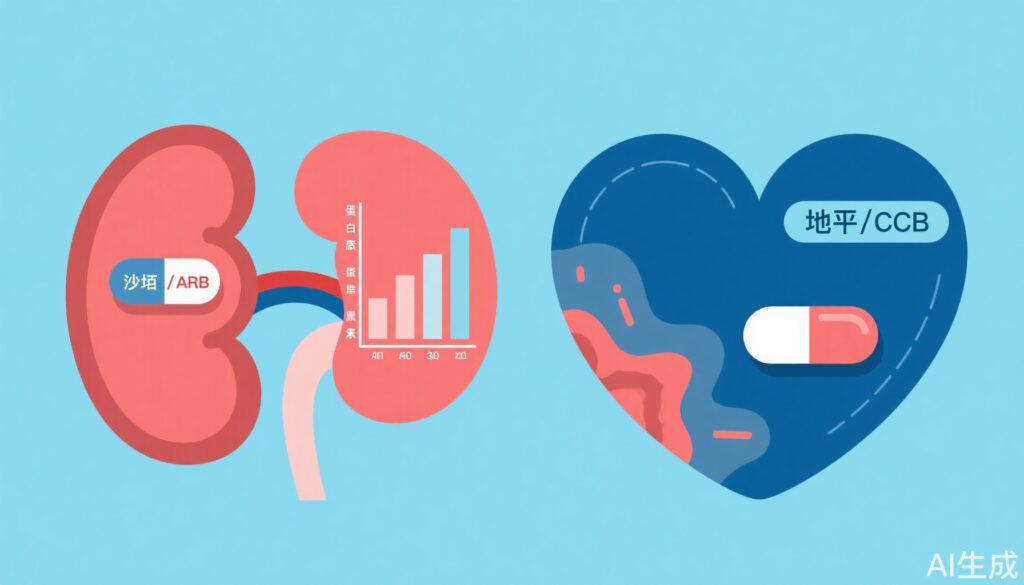Highlights
– ARBs have superior evidence for slowing progression of proteinuric chronic kidney disease, particularly in patients with diabetes; they reduce albuminuria and delay renal deterioration beyond blood-pressure lowering alone (RENAAL, IDNT, KDIGO recommendations). (Refs: RENAAL, IDNT, KDIGO.)
– Dihydropyridine CCBs (e.g., amlodipine) are effective antihypertensives with robust stroke prevention and are often useful for ischemic chest pain; some data suggest comparable or better prevention of myocardial infarction in specific comparisons, but results vary by trial and population.
– For heart failure prevention and treatment, ARBs have stronger evidence than DHP‑CCBs (Val‑HeFT, CHARM); CCBs—especially dihydropyridines—may be neutral or, in some settings, less favorable for heart‑failure outcomes.
– Treatment choice should be individualized: prioritize ARBs/ACE inhibitors for albuminuric CKD or heart‑failure risk; consider DHP‑CCBs for isolated systolic hypertension in older adults and for angina control; combination (ARB + DHP‑CCB) is a common and often effective option when monotherapy is insufficient.
Study background and disease burden
Hypertension is a leading modifiable risk factor for cardiovascular disease (myocardial infarction, heart failure, stroke) and for progression of chronic kidney disease (CKD). Preventing target‑organ damage—heart, brain, and kidneys—is the clinical objective beyond lowering blood pressure (BP). Two widely used antihypertensive classes are angiotensin receptor blockers (ARBs, commonly called drugs) and dihydropyridine calcium‑channel blockers (DHP‑CCBs, commonly called drugs, e.g., amlodipine, nifedipine). Clinicians frequently ask which class offers superior organ protection and how to select therapy according to comorbidity.
Large randomized controlled trials, disease‑specific outcome trials, and international guidelines provide the basis for treatment decisions. Major kidney outcome trials in diabetic nephropathy (e.g., RENAAL, IDNT) and heart‑failure trials (e.g., Val‑HeFT, CHARM) inform distinctions between ARBs and other classes. Guideline statements—KDIGO for CKD, ADA for diabetes, and ESC/ESH for hypertension—also guide first‑line selection when albuminuria or heart‑failure risk is present.
Evidence sources and study design overview
The comparative evidence arises from:
– Randomized controlled trials (RCTs) with hard renal and cardiovascular endpoints (RENAAL, IDNT, Val‑HeFT, ONTARGET).
– Head‑to‑head blood‑pressure trials and specialty RCTs comparing ARBs to other classes or to placebo for albuminuria and CKD progression.
– Large outcome trials and meta‑analyses assessing myocardial infarction, stroke and heart‑failure incidence by drug class.
– International practice guidelines (KDIGO 2021 for BP in CKD; ESC/ESH hypertension guidelines; ADA Standards of Care) synthesizing RCTs and observational data.
Endpoints used in these studies include changes in urinary albumin/protein excretion, doubling of serum creatinine or ESRD, cardiovascular death, nonfatal myocardial infarction (MI), stroke, heart‑failure hospitalization, and all‑cause mortality.
Key findings — renal protection
– ARBs reduce albuminuria and slow progression of proteinuric CKD: Trials in people with type 2 diabetes and nephropathy demonstrated that ARBs lowered the risk of progression to end‑stage renal disease and reduced proteinuria. The RENAAL (losartan) and IDNT (irbesartan) trials are landmark studies showing renoprotective effects independent, to some degree, of systemic BP lowering; these benefits include reduced proteinuria and slower decline in glomerular filtration rate (GFR). (Refs: RENAAL 2001; IDNT 2001.)
– Guidelines recommend RAAS blockade for albuminuric CKD: KDIGO and diabetes guidelines recommend ACE inhibitors or ARBs as first‑line therapy for patients with hypertension and albuminuria because of the class effect of renoprotection. (Refs: KDIGO 2021; ADA Standards of Care.)
– CCBs and renal outcomes: DHP‑CCBs effectively lower systemic BP and reduce stroke risk, but on average they are less effective than RAAS blockers at reducing intraglomerular pressure and proteinuria; CCBs do not consistently slow progression of proteinuric CKD to the same extent as ARBs/ACE inhibitors.
Clinical implication: In patients with diabetes or CKD with albuminuria, an ARB (or ACE inhibitor if tolerated) is the preferred first‑line antihypertensive for kidney protection. If a CCB is used, it is often as part of combination therapy when additional BP lowering is required, but RAAS blockade remains foundational for renoprotection.
Key findings — cardiac protection (myocardial infarction and heart failure)
– Myocardial infarction (MI)/ischemic heart disease: The relationship between antihypertensive class and MI reduction is complex and depends on achieved BP, baseline risk, and study population. Some trials and meta‑analyses have suggested comparable MI risk reduction across major antihypertensive classes when BP is similarly controlled; others report modest class‑specific differences in certain populations. DHP‑CCBs are effective at reducing ischemia and are commonly used when coronary vasodilation and prevention of angina are priorities. Large comparative trials such as ALLHAT and network meta‑analyses provide mixed signals; no consistent, robust superiority of ARBs over DHP‑CCBs for MI prevention has been established across all populations. (Refs: ALLHAT; meta‑analyses.)
– Heart failure (HF): Evidence favors RAAS blockade (ACEi/ARBs) over DHP‑CCBs for both prevention and treatment of heart failure. ARBs reduce HF hospitalization and improve symptoms and outcomes in patients with systolic dysfunction (e.g., Val‑HeFT showed benefit of valsartan in chronic HF). Conversely, DHP‑CCBs can cause peripheral edema and, in certain settings, may be less effective at preventing HF; therefore they are not first‑line agents for patients with reduced ejection fraction or high HF risk. (Refs: Val‑HeFT; CHARM.)
Clinical implication: For patients with established heart failure or high HF risk, ARBs are preferred. For patients with stable ischemic heart disease or symptomatic angina, DHP‑CCBs may be useful for chest pain control and BP control, but if HF risk exists, careful selection and combination with RAAS blockers are necessary.
Key findings — stroke prevention
– BP lowering reduces stroke risk across drug classes: The principal determinant of stroke risk reduction is the magnitude and consistency of BP lowering. Both ARBs and DHP‑CCBs reduce stroke incidence when they effectively lower BP.
– Relative class effects: Some analyses suggest DHP‑CCBs may confer slightly greater protection against stroke than some other classes for the same BP reduction, particularly in older patients with isolated systolic hypertension; however, differences are modest and not universally seen. Clinical decision should prioritize effective BP control and patient characteristics. (Refs: pooled analyses and hypertension guideline summaries.)
Safety and tolerability
– ARBs: Generally well tolerated; lower risk of cough than ACE inhibitors. Important adverse effects include hyperkalemia and an initial decline in GFR (particularly when starting or increasing dose—this often stabilizes and may reflect reduced intraglomerular pressure). Monitor serum creatinine and potassium after initiation. Avoid in pregnancy.
– DHP‑CCBs: Common side effects include peripheral edema, headache, flushing and reflex tachycardia (more at higher doses). In patients with heart failure with reduced ejection fraction (HFrEF), DHP‑CCBs are not recommended for routine use except amlodipine/nifedipine may be used if needed for ischemia because they are relatively neutral on mortality but can worsen congestion in susceptible patients.
Expert commentary and guideline synthesis
– Guideline convergence: International guidelines converge on a practical principle—use RAAS blockade (ACEi or ARB) as first‑line therapy in patients with hypertension and albuminuric CKD or diabetes with albuminuria because of demonstrated renal benefits. For heart failure with reduced EF, ARBs are part of the core disease‑modifying regimen (if ACEi or ARNI not used). For isolated systolic hypertension in older adults or for symptomatic angina, DHP‑CCBs are excellent choices.
– Individualization and combination therapy: Choice should be tailored to comorbidities (diabetes, CKD, coronary disease, heart failure), tolerability, age, and predominant BP phenotype (e.g., isolated systolic hypertension). When BP control requires two agents, ARB + DHP‑CCB is a well‑studied and commonly used combination that provides complementary mechanisms and often improves tolerability (reducing DHP‑CCB peripheral edema when combined with RAAS blockade).
– Limitations and evidence gaps: Direct head‑to‑head outcome trials comparing ARBs vs DHP‑CCBs for all organ outcomes (kidney progression, MI, stroke, HF) are limited. Much of the comparative inference combines trials with different populations and background therapies. Ongoing research on precision hypertension and organ‑specific outcomes may refine choices further.
Conclusion — practical recommendations
1) If the patient has hypertension plus diabetes and/or albuminuric CKD: prefer an ARB (or ACE inhibitor if not contraindicated) as first‑line because of stronger and consistent evidence for reducing albuminuria and slowing renal decline.
2) If the patient has established HFrEF or is at high risk for heart failure: prioritize ARB (or ACEi/ARNI) as part of guideline‑directed HF therapy; avoid monotherapy with DHP‑CCBs for HF prevention.
3) If the primary issue is ischemic heart disease or symptomatic angina, or isolated systolic hypertension in the elderly: a DHP‑CCB (e.g., amlodipine) is an appropriate choice and often provides excellent BP and ischemic symptom control.
4) For many patients, combination therapy (ARB + DHP‑CCB) is rational when monotherapy is insufficient—this strategy often improves BP control and balances class‑specific effects and side‑effect profiles.
5) Monitor for class‑specific adverse effects: check renal function and potassium after starting ARB; watch for peripheral edema and signs of worsening HF with DHP‑CCBs. Avoid pregnancy with ARBs.
References
1. Brenner BM, Cooper ME, de Zeeuw D, et al.; RENAAL Study Investigators. Effect of losartan on renal and cardiovascular outcomes in patients with type 2 diabetes and nephropathy. N Engl J Med. 2001;345(12):861–869.
2. Lewis EJ, Hunsicker LG, Clarke WR, et al.; IDNT Group. Renoprotective effect of the angiotensin‑receptor antagonist irbesartan in patients with nephropathy due to type 2 diabetes. N Engl J Med. 2001;345(12):851–860.
3. Cohn JN, Tognoni G; Valsartan Heart Failure Trial (Val‑HeFT) investigators. A randomized trial of the angiotensin‑receptor blocker valsartan in chronic heart failure. N Engl J Med. 2001;345(23):1667–1675.
4. Yusuf S, Teo KK, Pogue J, et al.; ONTARGET Investigators. Telmisartan, ramipril, or both in patients at high risk for vascular events. N Engl J Med. 2008;358(15):1547–1559.
5. KDIGO 2021 Clinical Practice Guideline for the Management of Blood Pressure in Chronic Kidney Disease. Kidney Int Suppl. 2021.
6. American Diabetes Association. Standards of Care in Diabetes—2024. Diabetes Care. 2024;47(Suppl 1).
7. The ALLHAT Officers and Coordinators for the ALLHAT Collaborative Research Group. Major outcomes in high‑risk hypertensive patients randomized to angiotensin‑converting enzyme inhibitor, calcium channel blocker, or diuretic. JAMA. 2002;288(23):2981–2997.
8. Messerli FH, Bangalore S, Bavishi C, Rimoldi SF. Angiotensin‑converting enzyme inhibitors in hypertension: to use or not to use? J Am Coll Cardiol. 2018;71(13):1474–1482. (Review on class effects and indications.)
9. Ettehad D, Emdin CA, Kiran A, et al. Blood pressure lowering for prevention of cardiovascular disease and death: a systematic review and meta‑analysis. Lancet. 2016;387(10022):957–967.
(Readers are encouraged to consult the full guideline documents and original trial reports for detailed inclusion criteria, subgroup findings and safety monitoring recommendations.)


